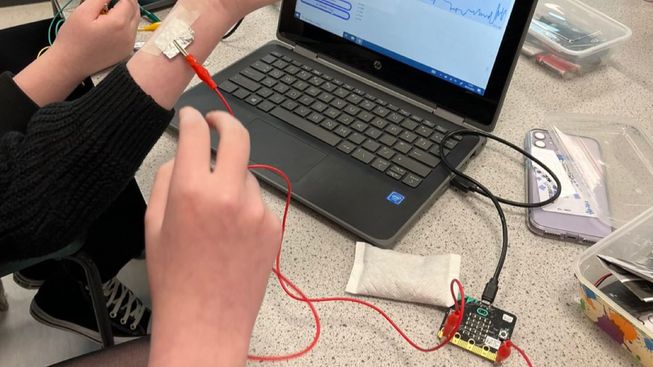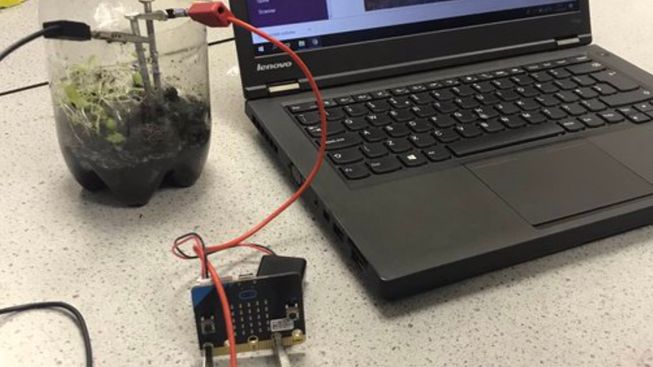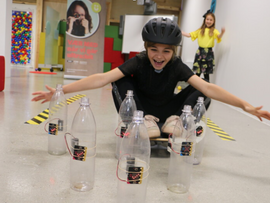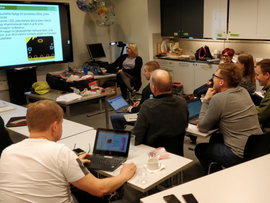Using micro:bits in science as a cross-curricular tool
Teachers tell us how they’ve used micro:bits to enhance their science teaching.

Imagine combining hands-on science investigations with exciting technology in your classroom - the micro:bit does exactly this, helping you engage and inspire your learners.
The BBC micro:bit is designed to make computing more physical, which makes it an ideal partner for science investigations. Three UK teachers explain how the micro:bit has helped them approach science and computing in a cross-curricular way.

micro:bits are cool! They add a different element to the obvious thermometers and other equipment. They grab the children’s attention quickly and are easy to use.

Claire Williams, teacher at Roath Park Primary in Cardiff, Wales
Why do micro:bits meet science requirements?
Clare Williams, a primary school teacher in Wales, came across micro:bits while looking at the programming element of the Digital Competence Framework (DCF), and found that they can cover the DCF within the science and technology Areas of Learning and Experience (AoLEs). She said: "Lesson planning is straightforward. It is easy to see the next steps or how the lesson can be adapted to other areas of learning. The AoLEs can be easily linked and it includes DCF skills."
Sarah Clark, a secondary school teacher and MIE Lead Fellow in Scotland, saw there could be added value in learning how technology and coding is used in science jobs: "A lack of Computing Science(CS) teachers meant student experience of CS was limited in the lower secondary years, but we knew it could be something that would fit into our science outcomes…I looked at how small coding tasks could be integrated into our current science curriculum, to add value to the lessons and develop students’ digital skills at the same time."
Learning the fundamentals of coding with the micro:bit can open other doors to learning, as Hannah MacGregor, a primary school teacher in Scotland, found: "The micro:bit provides real opportunities for interdisciplinary learning and once learners understand the basics of coding the micro:bit they can then extend this knowledge into different curricular areas."


It’s not always about the students coding, sometimes we have the code pre-made and the students download onto the micro:bit after a short chat about what the code means as a class. A full curriculum doesn’t always allow the students time to create the code from scratch, but they are learning how fundamental coding is in science.

Sarah Clark, teacher of Biology at Queen Anne High School in Dunfermline. MIE Lead Fellow Scotland.
How can micro:bits be used to teach science?
With so many features on the micro:bit, you can find at least one to explore and build an activity to suit your teaching. There are many excellent ways to use micro:bits to help make areas of science feel more tangible and relevant in the real world.
Sarah recalls her first examples: "My first use was with the STEM club where they designed a car and used the micro:bit to measure how fast it travelled down a slope with different surfaces (we gave a value of 1-5 depending on how fast it went). We then did some basic coding with the micro:bit, getting students to code them to make measurements like soil moisture, light intensity, temperature etc. These all fitted in well with our BGE [Broad General Education] curriculum.”
Claire used them to make pedometers to estimate how far the soldiers walked during King Charles’ Coronation Parade, and to measure the temperatures of a cup of tea as it cooled. She found the resources and tools on the website really helped as well: "The simulator meant that the children could rehearse what they were doing before programming the micro:bit… the website meant that I could extend the more able children and challenge them to improve their codes."
Hannah’s learners programmed them as soil moisture measurers to provide adequate water for their growing plants, which piqued their curiosity: "They began to ask about the solution if they did require more water. This led us as a class to investigating and coding our micro:bits including a servo and a pump so that, if the plant needed water, then the micro:bit would make this happen."


Learners are so engaged when learning with micro:bits. Every micro:bit lesson I have taught results in the learners asking for more learning with these incredible devices. This interest that learners have shown is partly why our school is focusing on STEM for our school improvement plan in the coming year.

Hannah MacGregor, teacher at Tulliallan Primary School in Scotland
The impact of micro:bits in science
All our teachers saw their learners get really engaged when using micro:bits in their science lessons. They encourage other teachers to use the step-by-step guidance and resources on the website and have a go.
In Claire’s parade pedometer lessons, she found that: "In two busy classes the children were all engaged." And, as she observes, "If scientists didn't make mistakes, how can they learn, improve and solve problems?" Sarah also encouraged this ‘have a go’ attitude despite confessing that she is "definitely not a coder!" She finds that her students now look at altering code and changing the context of the activity. Her advice? "Go play with it. Kids love doing it…The best way to learn is along with the students. You don’t need to be an expert in it, just willing to try it out."
If you feel inspired by these teachers, you can dive into science teaching with our professional development course and our quick science projects.


